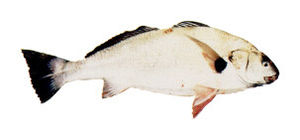Finspot Umber
| Finspot Umber | ||||||||||||
|---|---|---|---|---|---|---|---|---|---|---|---|---|

Pinned umber ( Roncador stearnsii ) |
||||||||||||
| Systematics | ||||||||||||
|
||||||||||||
| Scientific name of the genus | ||||||||||||
| Roncador | ||||||||||||
| Jordan & Gilbert , 1880 | ||||||||||||
| Scientific name of the species | ||||||||||||
| Roncador stearnsii | ||||||||||||
| ( Steindachner , 1876) | ||||||||||||
The Spotfin Croaker (Spotfin croaker, Roncador stearnsii ) is one of six species of croakers that on the west coast of the United States occur. It is the only species in the monotypical genus Roncador .
The scientific generic name Roncador , introduced by Jordan and Gilbert in 1880, means, similar to the English name croaker, an animal that makes harsh sounds (when caught); roncador is the Spanish (not Latinized) form of the Greek ρέγκων "snorer"; the species name honors the American fish collector Silas Stearns (1859–1888) from Pensacola in Florida . The fish was originally described as Corvina (a genus that has since been completely dissolved), so it is related to Sciaena umbra ( sea raven ).
features
The finned umber becomes 70 cm long and weighs almost 5 kg - it is then around 15 years old. The black base of the pectoral fin is one of several similar eye camouflage options, cf. Eye spot umber , white umber and others
Fin formula : D1 IX-X, D2 I / ~ 23, A II / 10; Sidelines -Schuppen: 63. No Bartel .
habitat
The fish lives in small groups on the west coast of Lower California , to the north about to Santa Barbara over a sandy bottom to a depth of about 15 m, where at night it mainly eats hard-shelled benthic invertebrates such as mussels , crabs and other crustaceans . During the day you can find it on rocks, posts, inlets, even in the very shallow.
He mostly swims in smaller schools, while large groups come together during the mating season. The eggs and larvae develop pelagically and are spread by the ocean currents.
Others
"Roncador" (as well as "Croaker", "Queenfish", "Drum" and others) were and are also called several conventional as well as nuclear submarines of the US Navy (the same probably applies to similar vehicles of other nationalities). This is used to disguise the fact that the engine noises “interfere” with those produced by the fish in various ways: for example, by using them (allegedly) for camouflage. No more precise information can be obtained about this, but at least the fact that these fish (like many other animals) are generally more and more disturbed by engine noise has long been a commonplace (acoustic pollution ).
Individual evidence
- ↑ AL Shanks and GL Eckert: Population persistence of California Current fishes and benthic crustaceans: a marine drift paradox. Ecological Monographs, 75:44, pp. 505-524, 2005
literature
- William N. Eschmeyer, ES Herald and H. Hammann: A field guide to Pacific coast fishes of North America. Houghton Mifflin Company, Boston 1983, ISBN 0-395-26873-7
Web links
- Finspot Umber on Fishbase.org (English)
- California Marine Sportfish: Spotfin croaker (Description)
- Roncador stearnsii inthe IUCN 2013 Red List of Threatened Species . Posted by: Chao, L. & Espinosa, H., 2007. Retrieved February 7, 2014.
